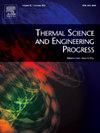喷淋水温对工业生物燃料锅炉辐射烟气中水滴滑移相变的影响
IF 5.1
3区 工程技术
Q2 ENERGY & FUELS
引用次数: 0
摘要
本文以工业生物燃料锅炉的技术注水应用为例,研究了在温度为200-1200℃的烟气流中,等效直径为50-500 μm、初始温度为40°C和90°C的水滴在复杂加热情况下的相变。假设烟灰包覆壁面在雾滴和烟气两相流中的辐射和多次反射提供了单个雾滴上黑体辐射的光谱强度。对流液滴加热被定义为初始雷诺数0-200。基于热通量平衡的液滴表面瞬时温度的迭代计算方法是一种最快收敛方法。在滑动液滴中,吸收的辐射与水的强制对流过程之间存在强烈的相互作用,这决定了液滴在相变状态下的热态和能态的复杂动力学。证明了注入水温度对液滴平衡蒸发的影响不显著,但对液滴过渡相变化有显著影响。有人建议用平衡蒸发温度与水温之比的参数来定义水的热状态,而不是根据感觉温度来评价它。本文章由计算机程序翻译,如有差异,请以英文原文为准。
Influence of sprayed water temperature on phase changes in droplets slipping in radiative flue gas flow of industrial biofuel boilers
This work presents the investigation of phase changes of water droplets with an equivalent diameter of 50–500 μm and initial temperatures of 40 °C and 90 °C in a flue gas flow with a temperature of 200–1200 °C in the case of complex heating, modeled from the application of technological water injection in industrial biofuel boilers. It was assumed that the radiation and multiple reflection of the soot-coated walls in the two-phase flow of droplets and flue gas provide the spectral intensity of blackbody radiation incident on an individual droplet. Convective droplet heating was defined by an initial Reynolds number of 0–200. A numerical scheme based on an iterative algorithm for determining the instantaneous temperature of the droplet surface, which works according to the fastest convergence method, is based on a balance of heat fluxes. It has been highlighted that in a slipping droplet, there is an intense interaction between absorbed radiation and forced convection processes of water, which defines the complex dynamics of the droplet’s thermal and energy state in phase change regimes. It has been justified that the influence of the temperature of the injected water on the equilibrium evaporation of droplets is insignificant, but it has a significant effect on transitional phase changes in droplets. It has been suggested that the thermal state of water be defined using a parameter expressed as the ratio of the equilibrium evaporation temperature to the water temperature, rather than evaluating it based on its sensory temperature.
求助全文
通过发布文献求助,成功后即可免费获取论文全文。
去求助
来源期刊

Thermal Science and Engineering Progress
Chemical Engineering-Fluid Flow and Transfer Processes
CiteScore
7.20
自引率
10.40%
发文量
327
审稿时长
41 days
期刊介绍:
Thermal Science and Engineering Progress (TSEP) publishes original, high-quality research articles that span activities ranging from fundamental scientific research and discussion of the more controversial thermodynamic theories, to developments in thermal engineering that are in many instances examples of the way scientists and engineers are addressing the challenges facing a growing population – smart cities and global warming – maximising thermodynamic efficiencies and minimising all heat losses. It is intended that these will be of current relevance and interest to industry, academia and other practitioners. It is evident that many specialised journals in thermal and, to some extent, in fluid disciplines tend to focus on topics that can be classified as fundamental in nature, or are ‘applied’ and near-market. Thermal Science and Engineering Progress will bridge the gap between these two areas, allowing authors to make an easy choice, should they or a journal editor feel that their papers are ‘out of scope’ when considering other journals. The range of topics covered by Thermal Science and Engineering Progress addresses the rapid rate of development being made in thermal transfer processes as they affect traditional fields, and important growth in the topical research areas of aerospace, thermal biological and medical systems, electronics and nano-technologies, renewable energy systems, food production (including agriculture), and the need to minimise man-made thermal impacts on climate change. Review articles on appropriate topics for TSEP are encouraged, although until TSEP is fully established, these will be limited in number. Before submitting such articles, please contact one of the Editors, or a member of the Editorial Advisory Board with an outline of your proposal and your expertise in the area of your review.
 求助内容:
求助内容: 应助结果提醒方式:
应助结果提醒方式:


